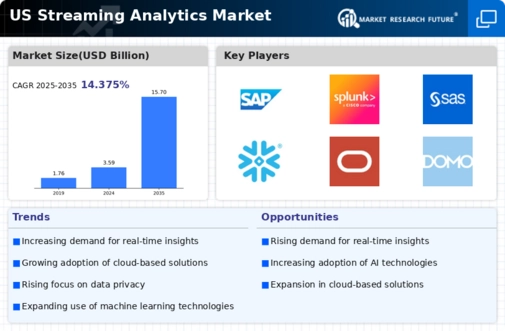Rise of IoT and Connected Devices
The proliferation of Internet of Things (IoT) devices is a key driver for the streaming analytics market. As more devices become interconnected, the volume of data generated is escalating rapidly. This influx of data necessitates advanced analytics solutions capable of processing and analyzing streams in real-time. Industries such as manufacturing, transportation, and smart cities are leveraging streaming analytics to optimize operations and improve service delivery. It is estimated that by 2026, the number of connected IoT devices will exceed 30 billion in the US alone, further fueling the demand for robust streaming analytics solutions that can handle vast amounts of data efficiently.
Increased Focus on Customer Experience
Enhancing customer experience has become a pivotal focus for businesses, driving the growth of the streaming analytics market. Companies are increasingly utilizing real-time analytics to gain insights into customer behavior and preferences, enabling them to tailor their offerings accordingly. This shift is particularly evident in the retail and e-commerce sectors, where personalized marketing strategies are becoming essential. Research indicates that organizations that effectively leverage streaming analytics to improve customer engagement can see revenue increases of up to 20%. As businesses strive to create more personalized experiences, the demand for advanced streaming analytics solutions is likely to continue its upward trajectory.
Regulatory Compliance and Data Governance
The need for regulatory compliance and effective data governance is emerging as a significant driver in the streaming analytics market. Organizations are under increasing pressure to adhere to various regulations concerning data privacy and security. This has led to a heightened focus on implementing analytics solutions that not only provide real-time insights but also ensure compliance with legal standards. Industries such as finance and healthcare are particularly affected, as they handle sensitive data that requires stringent governance. As regulatory frameworks evolve, the demand for streaming analytics solutions that facilitate compliance is expected to grow, thereby shaping the future landscape of the streaming analytics market.
Growing Demand for Real-Time Data Processing
The streaming analytics market is experiencing a notable surge in demand for real-time data processing capabilities. Organizations across various sectors are increasingly recognizing the value of immediate insights derived from data streams. This trend is particularly pronounced in industries such as finance, healthcare, and retail, where timely decision-making can significantly impact operational efficiency and customer satisfaction. According to recent estimates, the market for real-time analytics solutions is projected to grow at a CAGR of approximately 25% over the next five years. This growth is driven by the need for businesses to respond swiftly to market changes and consumer behaviors, thereby enhancing their competitive edge in the streaming analytics market.
Advancements in Technology and Infrastructure
Technological advancements and improvements in infrastructure are playing a crucial role in the evolution of the streaming analytics market. The advent of high-speed internet, cloud computing, and edge computing technologies has enabled organizations to process and analyze data streams more efficiently. These advancements allow for the deployment of sophisticated analytics tools that can handle large volumes of data in real-time. As businesses increasingly adopt these technologies, the market for streaming analytics is likely to expand. It is anticipated that by 2027, investments in analytics infrastructure will reach upwards of $50 billion in the US, further propelling the growth of the streaming analytics market.

























Leave a Comment